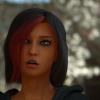natural realistic eye animation
 Chris Fox Art
Posts: 380
Chris Fox Art
Posts: 380
I've thought a lot about natural realistic animations and have a question as i haven't tried out it yet.
I think the eyes are the hardest to achieve natural realism in the look, it's easy to achieve realism in a static image but on an animation it looks a bit different.
I don't only talk about the eye moving around, my question goes more to the affection of light.
If a lightsource goes in the direction to the eye, the iris and pupil will change a bit, the pupil gets smaller, the iris bigger but even it structure changes.
When the eyes goes in the other direction, the iris gots smaller and the pupil gets bigger.
Have anybody tried out to animate this before?
I know you can change the color of an object in an animation very smoothly, is this the way to go than?
I doubt a little that this will works as fine with textures too, so that 2 different textures might not be enough.
Any thoughts about this?


Comments
here's a little piece I put together many years ago https://sites.google.com/site/waxfin/eyeballtutorial
Just use morphs for the pupils - as the eye turns the lids will change shape to accomodate the cornea - use morphs for that too
the iris just stretches as the pupil gets smaller and bunches as it gets bigger - you don't need to change the texture, the texture on your mesh will change automatically
be aware of Purkinjie images - reflections off the optical surfaces within the eye; sclerotic scatter (light dispersed in cornea); and that if you shine a light in one eye then the other pupil will also constrict.
The thing that I see that most stills fall down with are tear meniscus and the caruncle see- https://en.wikipedia.org/wiki/Lacrimal_caruncle
So I reckon animations will be worse.
Here's a simple animation from 2007 - everything is morphs. Mind you, if you had an eye like this one you'd trade it in.....
Thanks a lot for the input, the animation looks very interesting.
So with morphs should be the easiest and best way to go than.
HI Chris :)
As Headwax mentioned,. it's a morphs thing,.
Have a close up look at the eye of any figure in the vertex modeller,. there you can see the different model parts of the eye,.
there are Morphs to adjust the shape of these parts,. Pupil Dilate etc,.,. you can also create custom morphs in carrara,. or purchase third party morphs such as "Creature creator" for more options.
morphs values are keyframable,. so you can animate,.. and save that as NLA to re-use on other figures.
for eye animation,. try using the Noise and Discreet tweeners .
Hope it helps :)
never tried discreet tweener, dont understand what it does
Think of it like a switch. Nothing happens between discrete tweeners. It is a great way to help control the unwanted movement you get sometimes when using something like the bezier tweener.
What I like to do sometimes is to have the eyeballs track a Target Helper. Especially during a walk cycle. Another animation trick, is if you are going to have the character turn their head and look at something, rotate the eyes in that direction before you move the head. And don't forget the blinks! If I am doing an animation at 30 frames per second, I allow three frames for the eye to close, one frame close, and three to open again. It is fast enough to appear natural, yet slow enouh for it to register in the video. To simplify your life, make an NLA clip for the eye blink and use that over again as many times as needed.
the discreet tweener in the eye blinks?
No. use the discreet tweener between eye movements and blinks- where you don't want movement.
Here I used a discreet tweener to stop unwanted side to side eyemovement. I wanted A3 to look in one direction for an extended period of time, and then look off to the side in just a few frames, beginning just before she begins turning her head.
Here is an example of what the animation I referenced in my last post looked like.
